There are loads of different pedals out there on the market. While it may be widely agreed upon regarding where certain pedals should go in the signal chain, others exist in a sort of gray area.
EQ pedals, possibly one of the most versatile pedals a guitarist could own, are among the kind that have no definitively correct positioning. An EQ could take on several different roles and qualities depending on where you choose to connect it.
Generally, you can put an EQ pedal with dynamics pedals such as compression which usually follows utility, filters, wah, and pitch shifters. But putting EQ after drive and distortion is another great place, as is the FX Loop, where you can modify the tonal characteristics of the amp.
We’re going to take a closer look at the top three places you may choose to set up your EQ pedal. After all, regardless of what style of music you play, EQ is an essential part of any guitarist’s rig.
Where EQ Can Go In Your Signal Chain
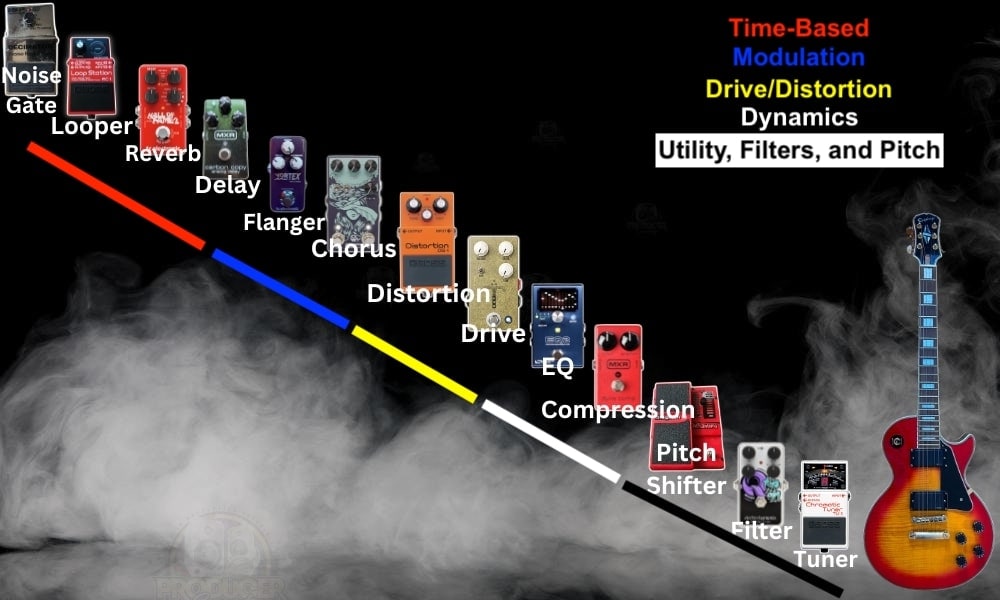
An EQ pedal like the Source Audio Programmable EQ2 is one of those pedals that can go pretty much anywhere in your chain, a lot like a noise gate.
For a noise gate (my tutorial), you can put them anywhere where there’s noise. And with EQ, you can do the same thing, except thinking in terms of frequencies and equalization.
However, my personal preference is to put my EQ after compression and before drive and distortion. The main difference with placing the EQ before or after distortion and compression is the signal you’d be equalizing.
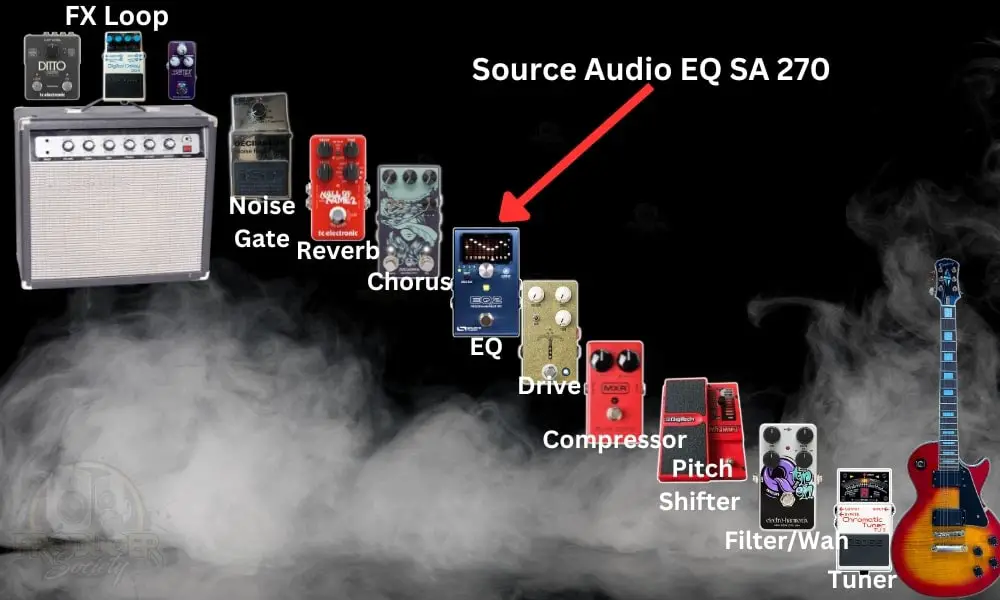
Placing EQ after these pedals in question means that we’re adjusting the frequencies after they’ve already been altered by compression and drive. This is probably the best way to do it if you’re not super into drive and distortion.
These days, I’m the type of player who loves a slight overdrive and just a bit of compression, so throwing EQ on top to make certain frequencies sound good is awesome for me.
For example, you can even add some frequencies in the upper-mid range to imitate more of a Stratocaster sound. That’s the beauty of using an EQ.
Likewise, as discussed in this video by Middle Aged Gear Junkie, if this EQ setup sees your pedal placed at the start of your chain, it could also serve as a buffer.
For this purpose, we’ll want to specifically heighten the higher frequencies so that they aren’t quashed as noticeably down the line. But as I said, there is more than one way to skin a cat.
3 Other Locations for Your EQ Pedal
There is no objectively right or wrong place for your EQ pedal as long as it’s doing what you want it to do. The possibilities are only limited by the number of pedals you have at your disposal.
If your amp has an FX loop, or if you’re using a larger signal chain, consider the following options.
1) In Your FX Loop
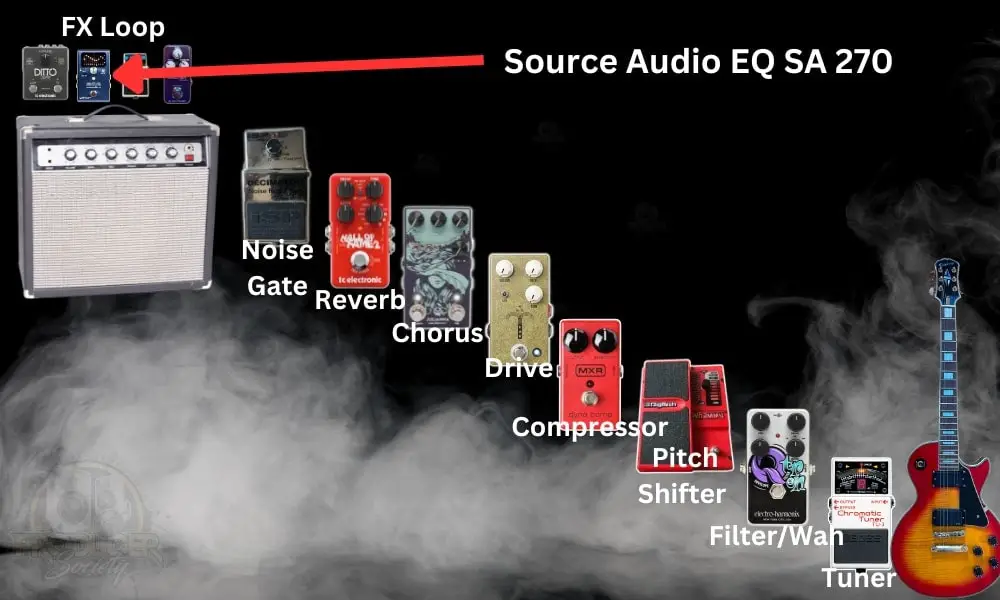
There are a couple of key benefits to having your EQ pedal set up in your amp’s FX loop.
Essentially, this configuration allows you to bypass the pedals in your signal chain and it places your EQ after the pre-amp, something I’ve discussed in more detail before.
Now, if you’re unsure whether your amp has an FX loop, take a look at the backside of the amp. If you see two jacks, one labelled “Send” and the other “Return,” then you’re good to go. But what exactly does placing EQ in your FX loop do?
As you can see in this video by Antoine Michaud, the FX loop separates the pedals within it from the pre-amp and everything that comes before it.
Your overdrive, distortion, compression, and any other pedals you have chained into your amp are all affected by the pre-amp setup.
Therefore, having your EQ in the FX loop doesn’t so much adjust your guitar’s frequencies, but the frequencies of your amp itself.
Most every amp you come across will feature its own sort of EQ in the form of the “bass,” “middle,” and “treble” knobs.
However, you can get much more accurate adjustments by using an EQ pedal like the MXR 10-Band EQ, another pedal I have a tutorial on.
For example, maybe you aren’t happy with the way mid-range frequencies sound on your amp. With an EQ pedal in the FX loop, you can bring out more of those frequencies while pushing back competing ones.
After all, why settle for the built-in three-band EQ when you could have a ten-band? Overall, placing the EQ in the FX loop will have a much more dramatic effect on your sound than placing it anywhere in the signal chain.
2) At the End of Your Signal Chain
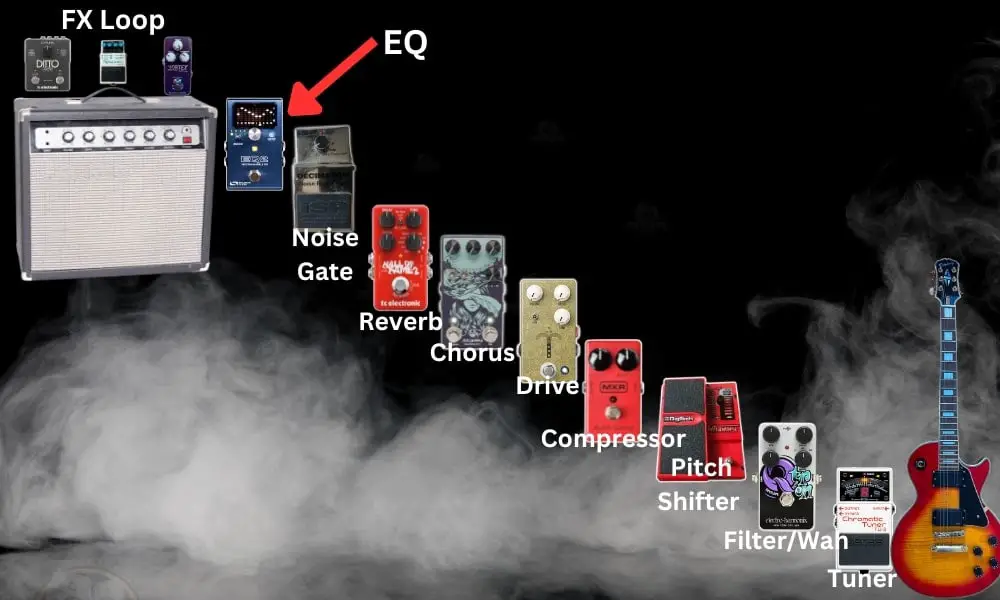
Sometimes, you simply want to clean things up without changing the tone all that much. With your EQ pedal at the end of your signal chain, you’re affecting all of the pedals that come before it, but you’ll not be altering the sound of your amp.
As mentioned before, having your EQ in this position will do less to change the qualities of the former pedals in the chain. Still, you’ll be able to fine-tune the volume of the frequency bands you find problematic or underrepresented.
Similar to a buffer, we’re using the EQ to correct the negative effects of a larger signal chain. For most guitarists, this will mean implementing a high-pass filter or raising the higher frequencies to bring out a clearer tone.
These options, like the position of your EQ pedal, are not the same thing. A high-pass filter brings out higher frequencies by suppressing the lower frequencies on a curve that flattens out near the mid-range bands.
Alternatively, raising the levels for the higher-frequency bands leaves the low end unaffected. However, this is not to say that there won’t be competition between the two extremes.
Of course, you can do both if the brightness of your tone is really suffering, but we also don’t want to solve one problem by creating another.
In the end, the placement and levelling of your EQ pedal are up to you. As long as it’s helping you achieve the tones you’re looking for, there are no wrong answers.
3) Before or After Drive & Distortion
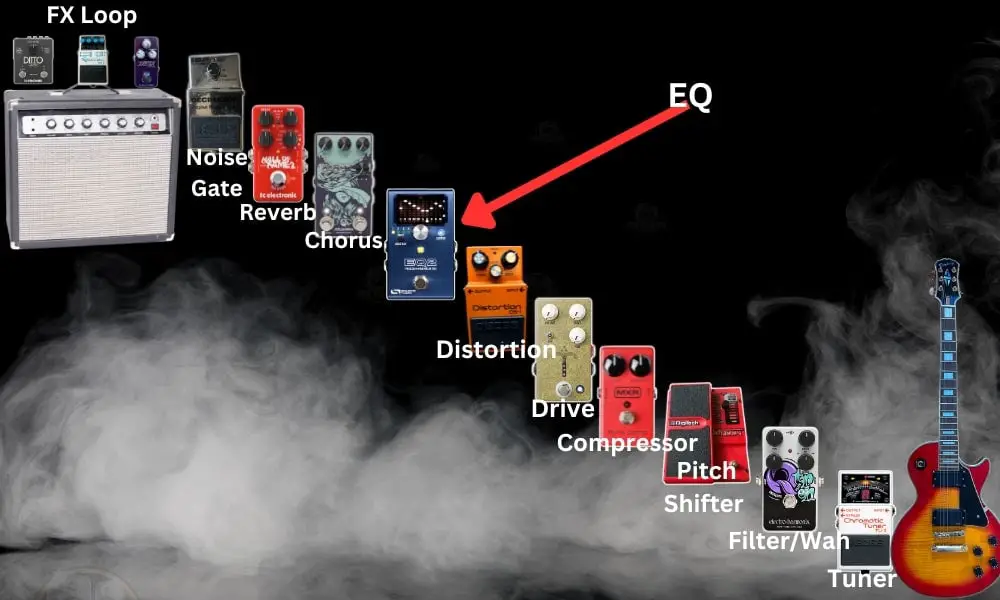
I’m learning new things every day about signal chain placement, and playing the guitar, in general. But something I’ve been experimenting with is putting EQ before and after drive and distortion.
As I’ve already said, I normally put it before drive. There is a difference between the two.
My reasoning for this has to do with the way I understand distortion pedals, which is that they cause your signal to clip or top out on purpose, in other words, “hard-clipping.” That’s how you get the distorted sound.
But with drive, like my JHS Morning Glory, for instance, it’s a bit of a different story because they just dirty up your signal a bit via soft-clipping, rather than hard-clipping.
But it depends on what you’re trying to do. Using EQ after distortion is something that could do as well because if your distortion doesn’t have enough top-end, you could always add it with an EQ.
And this brings me to my next point, which is that it seems to me like EQ is one of the most versatile pedals in terms of where you can put it in your chain. Put it wherever you want or wherever you think it needs it.
Other Articles You May Be Interested In
- Where to Put Distortion In Your Signal Chain (SIMPLE)
- Where To Put the Ditto X2 Looper In Your Signal Chain?
- Where to Put The Flanger In Your Signal Chain? (Quick Tip)
- Where Should A Tremolo Pedal Go In The Signal Chain? [EASY]
- Where Should The Whammy Pedal Go In The Signal Chain? [EASY]
- Where To Put The Looper Pedal In Your Signal Chain [SIMPLE]

 Written By :
Written By :
